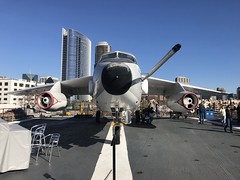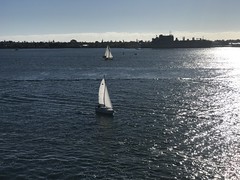
Initially I didn’t plan on visiting the USS Midway Museum as it sits right in the most touristy part of San Diego, next to the cruise ship terminals. But glowing reviews online made me figure it was worth a visit, especially considering I wanted to see the Maritime Museum which is just down the street. Besides, the museum itself is an aircraft carrier — not a place most of us civilians would get to see up close.
So I bought a ticket and headed over. I decided to walk since I needed to burn off all those calories from the Tijuana street food tour yesterday.
It’s easy enough to find the USS Midway Museum, but on my walk over I noticed something that made my heart stop for a second: an enormous cruise ship — taller than the Midway herself — was docked right next door. That meant thousands of potential more tourists to compete with!
Worse as I soon found out the USS Midway Museum doesn’t handle crowds well. You have to wait in up to six lines to get in: bag check, ticket check, mandatory photo, plus one if you drove and want to park there, plus one if you didn’t buy a ticket in advance, plus one if you want an audio guide.
Strangely none of these lines did much for crowd control, so once I got into the main area — the hangar deck — it was quite crowded and hard to move around. The hangar deck has a wide array of exhibits, but the main attraction seems to be some flight simulator rides. For the kids that’s probably fun, but not really what I came to see.
The most interesting part by far is the flight deck up on top. Since the Midway was in service from 1945 through 1992 it’s seen a number of different types of aircraft, from propeller planes to helicopters to cargo aircraft to fighter jets — and they have one of everything. Some of them you can climb or walk into.
But the best part of the flight deck isn’t the airplanes, it’s the navy veteran tour guides explaining how it all worked. Some interesting things I learned:
- Planes could take off or land every 45 seconds at peak capacity.
- To land, planes had to catch a cable that would bring them to a quick and unpleasant stop. I saw several videos of this in action, both in day and at night.
- Planes had to land with their engines at maximum, because if the cable mechanism didn’t work they’d have to take off again. Once more there was a video of this. According to the guide this only happens once every 25 years or so.
- If the plane could fly but was too damaged to land properly, they’d set up a giant net on the runway to catch the plane. The ship’s firefighters were on hand for rescue. The video of this was too insane to describe, it looked like something out of a Road Runner cartoon. Yet the guide said the pilot’s only injuries in this particular case were pulled muscles and he was out flying again the next day, and even the jet fighter itself took only ten days to repair.
Nothing else was quite as impressive as those talks and videos, but a close second is the views from up on the flight deck. On the one side you’ve got downtown San Diego, the bay on the other.
Around the time I was thinking of leaving I was getting a little thirsty — they’re very picky about the water bottles allows on board — so I checked the vending machines. They were all sold out of everything! Worse, the cafes had long lines.
In the end I think my initial snap judgement of the USS Midway Museum was partially correct: yes, it’s super touristy and as such can be crowded. On the other hand if you want to learn more about post World War II military history it’s the place to go.
My recommendation: If you’re interested in the military, ships, and/or airplanes definitely check it out, otherwise skip it. Buy tickets online (it’s cheaper and you skip the main entry line) and either walk or take the trolley if possible. Wear sunscreen and/or a hat because the most interesting parts are all on the flight deck up top.


